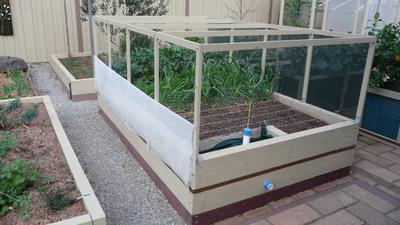Cold Composting V Wicking Worm Beds
by John Ashworth
(Melbourne, Victoria, Australia)

Wicking Worm Bed Setup in Melbourne Australia
John uses two very different methods of composting at his Melbourne Australia home. The first is his take on cold or passive composting. The second is a drought strategy, a worm wicking bed.
Cold Composting
For years I have kept myself supplied with good quality regenerated soil. I don't know if you would call it compost since about 20% of it starts out as soil from my vegetable beds.
I build up my pile with alternate layers of kitchen and garden organic waste and soil. The waste is about 250mm thick and the soil is about 50mm.
When I have a cubic meter (usually after 6 months), I invert the pile by throwing it into the next compartment of my 2 bin arrangement. The well rotted material is now on top, and I begin to use this right away on my garden beds. I gradually use it over the next 6 months, and the bugs keep ahead of me breaking the material down.
Worm Wicking Beds
After a 15 year drought in Melbourne (AUS) a couple of years ago, I decided to convert my vegie patches to Wicking Beds. These are raised garden beds with a built in water tank.
The water wicks up into the soil and is an extremely frugal user of water, only requiring a refill once a week in our hot dry summer, and hardly ever in winter.
Maintaining good worm microbic activity is a problem with wicking beds, so I followed the example of a number of Australian gardeners, and built a worm farm in each of them. I go to great lengths to make it easy for my worms by selecting their food carefully and chopping it fine in a food processor.
Each worm farm (I have 8) gets a large handful of food every 2-3 days. It is processed by the microbes and worms in a week. I have composting and burrowing worms in my bed to maximize breakdown and distribution of the food throughout the bed.
Still Making and Using the Cold Compost
I still make my compost because I feel it is necessary to use it as a top dressing in my wicking worm beds to maintain bacterial/fungal diversity in the soil biology. So far, it works well and my vegetables develop quicker, are bigger and taste great. What more can you ask for.
Thanks for a really great read. I have taken the liberty of adding your site to links in my own blog.
Thanks John
Thanks John for your excellent story. Very interesting to hear about strategies to deal with the drought some parts of the planet are coping with. John's wicking bed page can be found by clicking here.
Return to Compost Confessions.